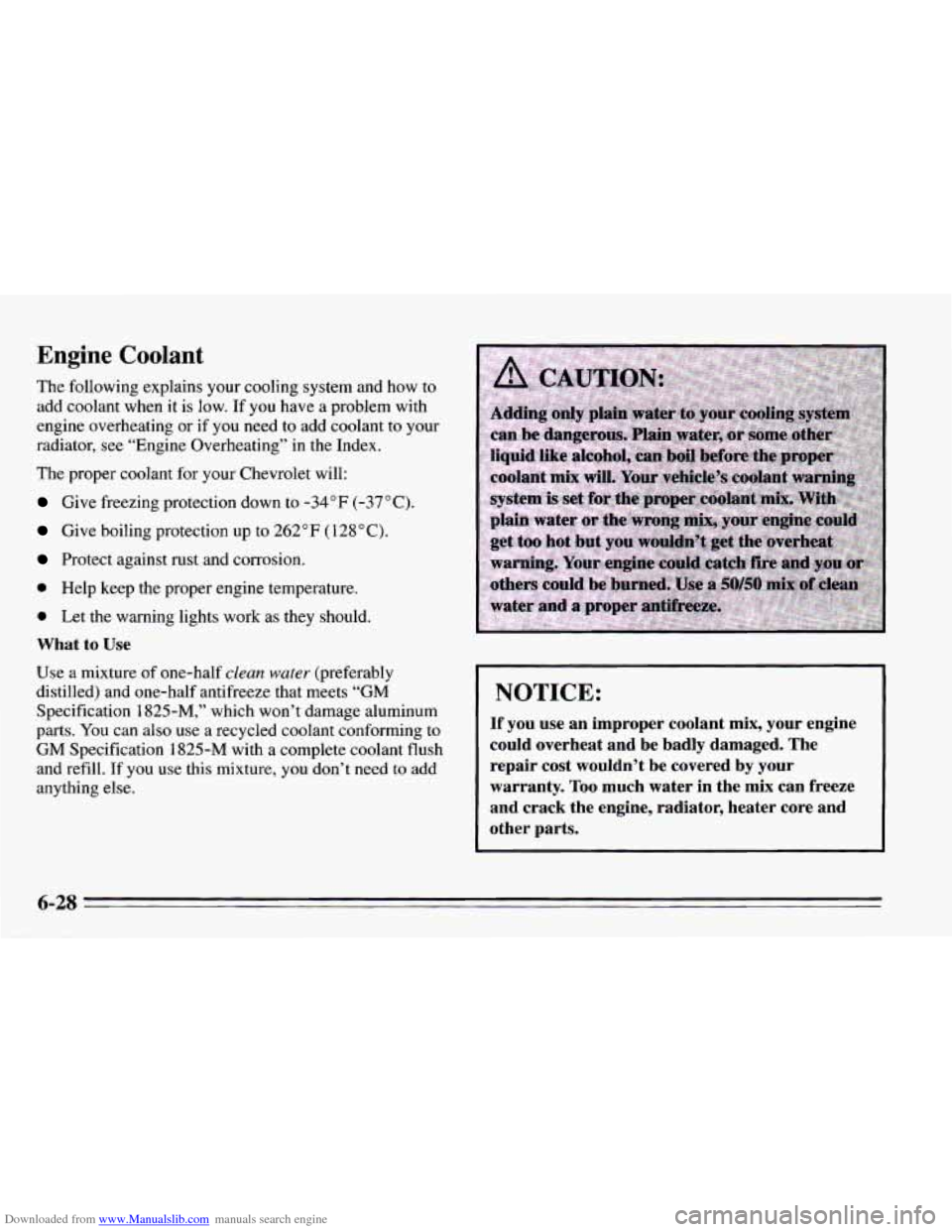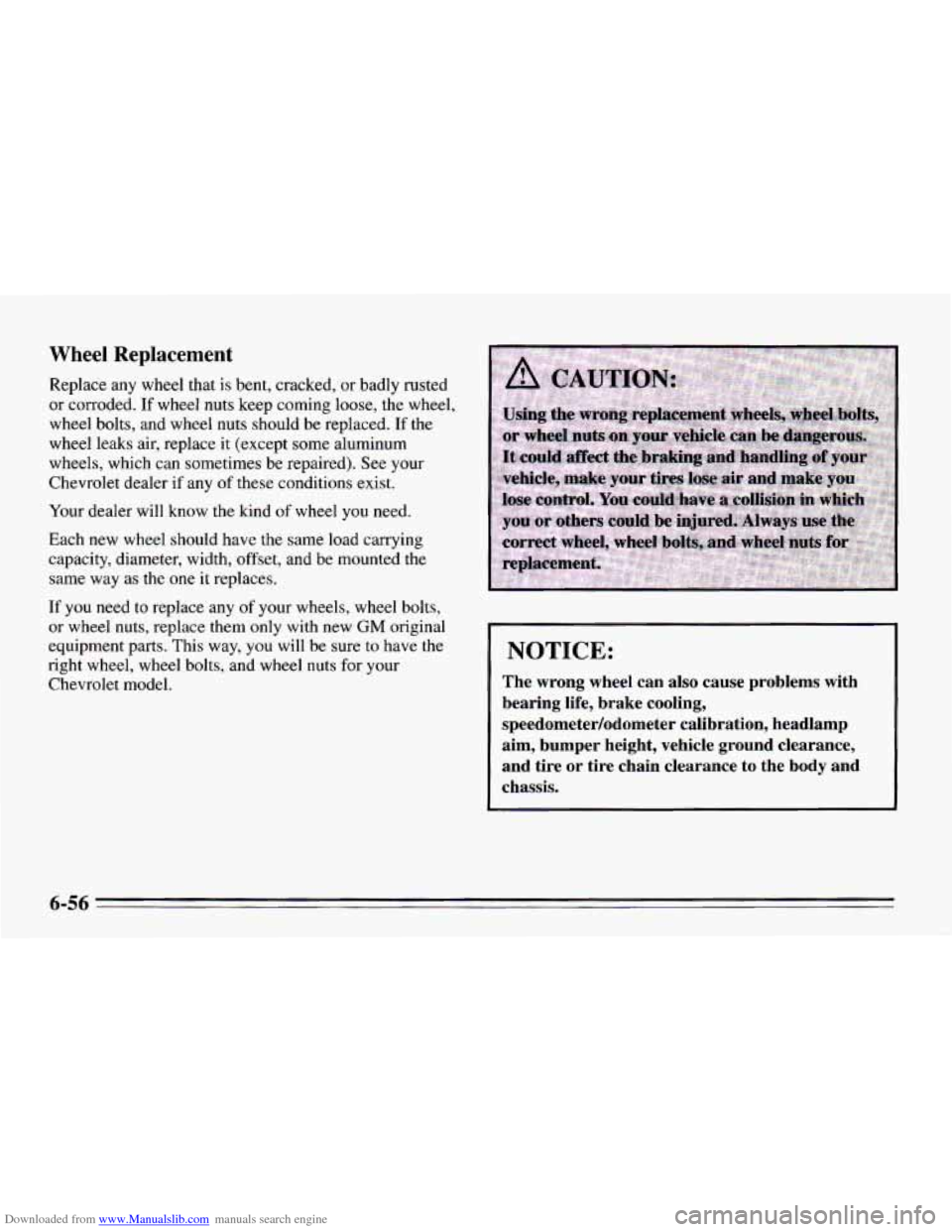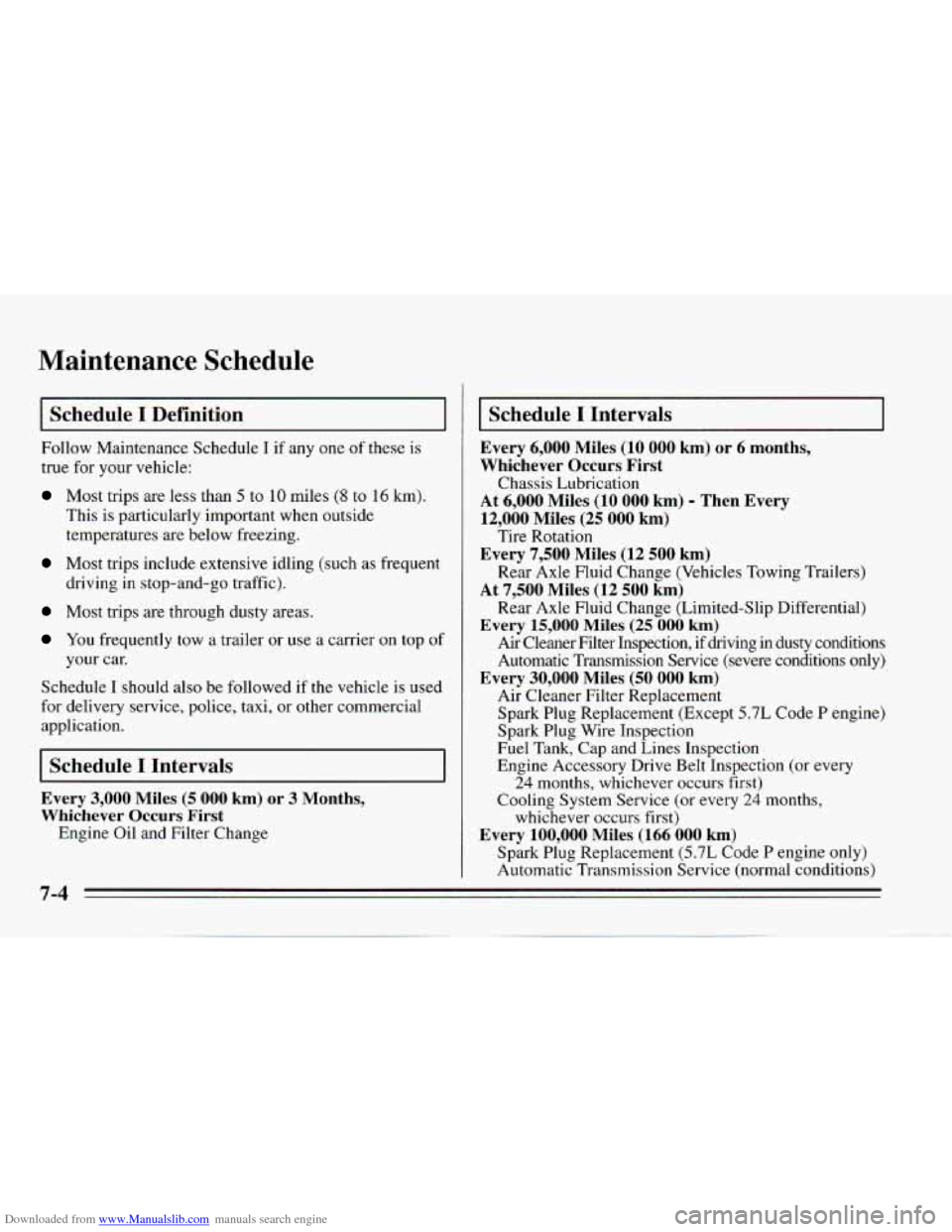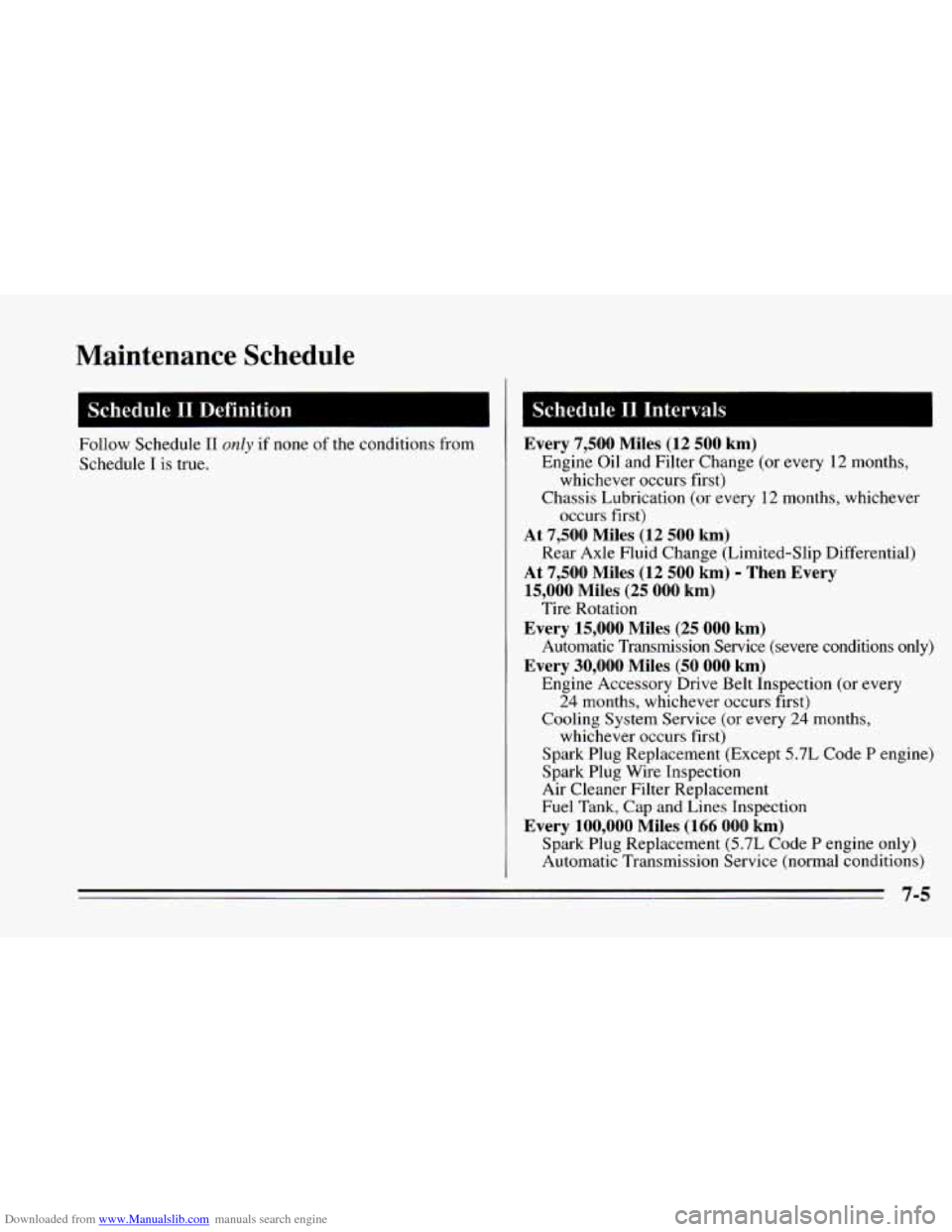Page 213 of 388
Downloaded from www.Manualslib.com manuals search engine HOW to Add Coolant to the Radiator
(V-6 Engines)
2. Then keep turning the pressure cap, but now push
down as you turn
it. Remove the pressure cap.
1. You can remove the radiator pressure cap when the
cooling system, including the radiator pressure cap
and upper radiator hose,
is no longer hot. Turn the
pressure cap slowly to the left until
it first stops.
(Don’t press down while turning
the pressure cap.)
If you hear a hiss, wait for that to stop. A hiss means
there is still some pressure left.
5-19
Page 217 of 388
Downloaded from www.Manualslib.com manuals search engine 1. You can remove the radiator pressure cap when the
cooling system, including
the radiator pressure cap
and upper radiator hose, is
no longer hot. Turn the
pressure cap slowly to the left until it first stops.
(Don’t press down while turning
the pressure cap.)
If you hear a hiss, wait for that to stop. A hiss means
there is still some pressure left.
2. Then keep turning the pressure cap, but now push
down
as you turn it. Remove the pressure cap.
5-23
Page 260 of 388

Downloaded from www.Manualslib.com manuals search engine Engine Coolant
The following explains your cooling system and how to
add coolant when it
is low. If you have a problem with
engine overheating or if you need to add coolant to your
radiator, see “Engine Overheating”
in the Index.
The proper coolant for your Chevrolet will:
Give freezing protection down to -34°F (-37°C).
Give boiling protection up to 262” F ( 128 * C).
Protect against rust and corrosion.
0 Help keep the proper engine temperature.
0 Let the warning lights work as they should.
What to Use
Use a mixture of one-half clean water (preferably
distilled) and one-half antifreeze that meets
“GM
Specification 1825-M,” which won’t damage aluminum
parts.
You can also use a recycled coolant conforming to
GM Specification 1825-M with a complete coolant flush
and refill. If you use this mixture, you don’t need to add
anything else.
I NOTICE:
If you use an improper coolant mix, your engine
could overheat and
be badly damaged. The
repair
cost wouldn’t be covered by your
warranty.
Too much water in the mix can freeze
and crack the engine, radiator, heater core and
other parts.
6-28
Page 288 of 388

Downloaded from www.Manualslib.com manuals search engine Wheel Replacement
Replace any wheel that is bent, cracked, or badly rusted
or corroded. If wheel nuts keep coming loose, the wheel,
wheel bolts, and wheel nuts should be replaced. If the
wheel leaks air, replace it (except some aluminum
wheels, which can sometimes be repaired). See your
Chevrolet dealer if any
of these conditions exist.
Your dealer will know the kind
of wheel you need.
Each new wheel should have the same load carrying
capacity, diameter, width, offset, and be mounted the
same way as the one it replaces.
If you need
to replace any of your wheels, wheel bolts,
or wheel
nuts, replace them only with new GM original
equipment parts. This way,
you will be sure to have the
right wheel, wheel bolts, and wheel nuts
for your
Chevrolet model. I NOTICE:
The wrong wheel can also cause problems with
bearing life, brake cooling,
speedometerlodometer calibration, headlamp
aim, bumper height, vehicle ground clearance,
I and tire or tire chain clearance to the body and
chassis.
6-56
Page 306 of 388

Downloaded from www.Manualslib.com manuals search engine Capacities and Specifications
Engine
Type VIN Engine Code
S and K ................... V6
VIN Engine Code
P ........................ V8
Fuel Delivery
...................... Fuel Injection
Valve Arrangement
...................... In-Head
Piston Displacement
VIN Engine Code
S .............. 207 CID (3.4L)
VIN Engine Code
K .............. 23 1 CID (3.8L)
VIN Engine Code
P .............. 350 CID (5.7L)
VIN Engine Code
S and K ................. 9.0: I
VIN Engine Code P ..................... 10.5: 1
VIN Engine Code S and K ........... 1-6-5-4-3-2
VIN Engine Code
P ............ 1-8-4-3-6-5-7-2
Compression Ratio
Firing Order
Wheel Nuts
Wheel Nut Torque ... 100
Ib. ft. (I 40 N-m)
Capacities (Approximate)
The following approximate capacities are given in U.S.
and metric conversions.
Air Conditioning?
..... See the refrigerant information
label under the hood.
Automatic Transmission
Drain and Refill
.................. IO pt. (4.7 L)*
VIN Engine Code S and K . . , . . , . . 17.6 pt. (8.3 L)*
VIN Engine Code P ............ 2 1.6 pt. (1 0.2 L)*
VIN Engine Code S
Overhaul
Cooling System
With Manual Transmission
...... 12.5 qt. (1 1.8 L)
With Automatic Transmission
, . . , 12.3 qt. (1 1.6 L)
With Manual Transmission
...... 12.5 qt. (1 1.8 L)
With Automatic Transmission .... 12.3 qt. (1 I .6 L)
With Manual Transmission ...... 15.3 qt. (14.5 L)
With Automatic Transmission
.... 15.1 qt. (14.3 L)
VIN
Engine Code
K
VIN Engine Code P
6-74
Page 312 of 388

Downloaded from www.Manualslib.com manuals search engine Maintenance Schedule
Schedule I Definition
Follow Maintenance Schedule I if any one of these is
true for your vehicle:
Most trips are less than 5 to 10 miles (8 to 16 km).
This is particularly important when outside
temperatures are below freezing.
Most trips include extensive idling (such as frequent
driving in stop-and-go traffic).
Most trips are through dusty areas.
You frequently tow a trailer or use a carrier on top of
your car.
Schedule
I should also be followed if the vehicle is used
for delivery service, police, taxi, or other commercial
application.
Schedule I Intervals
Every 3,000 Miles (5 000 km) or 3 Months,
Whichever Occurs First
Engine Oil and Filter Change
Schedule I Intervals
Every 6,000 Miles (10 000 km) or 6 months,
Whichever Occurs First
Chassis Lubrication
At 6,000 Miles (10 000 km) - Then Every
12,000 Miles (25 000 km)
Every
7,500 Miles (12 500 km)
At
7,500 Miles (12 500 km)
Every
15,000 Miles (25 000 km)
Tire Rotation
Rear Axle Fluid Change (Vehicles Tow11
I Trailers)
Rear Axle Fluid Change (Limited-Slip Differential)
Air Cleaner Filter Inspection,
if driving in dusty conditions
Automatic Transmission Service (severe conditions only)
Every 30,000 Miles (50 000 km)
Air Cleaner Filter Replacement
Spark Plug Replacement (Except
5.7L Code P engine)
Spark Plug Wire Inspection
Fuel Tank, Cap and Lines Inspection
Engine Accessory Drive Belt Inspection (or every
24 months, whichever occurs first)
Cooling System Service (or every
24 months,
whichever occurs first)
Every 100,000 Miles (166 000 km)
Spark Plug Replacement (5.7L Code P engine only)
Automatic Transmission Service (normal conditions)
7-4
Page 313 of 388

Downloaded from www.Manualslib.com manuals search engine Maintenance Schedule
Schedule I1 Definition I
Follow Schedule I1 onZy if none of the conditions from
Schedule
I is true.
Every 7,500 Miles (12 500 km)
whichever occurs first)
occurs first)
Engine
Oil and Filter Change (or every 12 months,
Chassis Lubrication (or every
12 months, whichever
At 7,500 Miles (12 500 km)
At 7,500 Miles (12 500 km) - Then Every
15,000 Miles (25
000 km)
Every 15,000 Miles (25
000 km)
Every
30,000 Miles (50 000 km)
Rear Axle Fluid Change (Limited-Slip Differential)
Tire Rotation Automatic Transmission Service (severe conditions
only)
Engine Accessory Drive Belt Inspection (or every
24 months, whichever occurs first)
Cooling System Service (or every
24 months,
whichever occurs first)
Spark
Plug Replacement (Except 5.7L Code P engine)
Spark Plug Wire Inspection
Air Cleaner Filter Replacement
Fuel Tank, Cap and Lines Inspection
Every 100,000 Miles (166 000 km)
Spark Plug Replacement (5.7L Code P engine only)
Automatic Transmission Service (normal conditions)
7-5
Page 320 of 388
Downloaded from www.Manualslib.com manuals search engine I Maintenance Schedule I I
27,000 Miles (45 000 km)
0 Change engine oil and filter (or every
3 months, whichever occurs first).
An Emission Control Service.
30,000 Miles (50 000 km)
0 Change engine oil and filter (or every
3 months, whichever occurs first).
An Emission Control Sewice.
0 Lubricate the steering linkage. Lubricate the
transmission shift linkage (or every
6 months, whichever occurs first).
0 Change the rear axle gear lubricant if
vehicle is used to pull a trailer.
Inspect engine accessory drive belt (or
every
24 months, whichever occurs first).
An Emission Control Service
0 Drain, flush and refill cooling system (or
every
24 months, whichever occurs first).
See “Engine Coolant” in the Index for what
to use. Inspect hoses. Clean radiator,
condenser, pressure cap and neck. Pressure
test the cooling system and pressure cap.
An Emission Control Service.
7-12